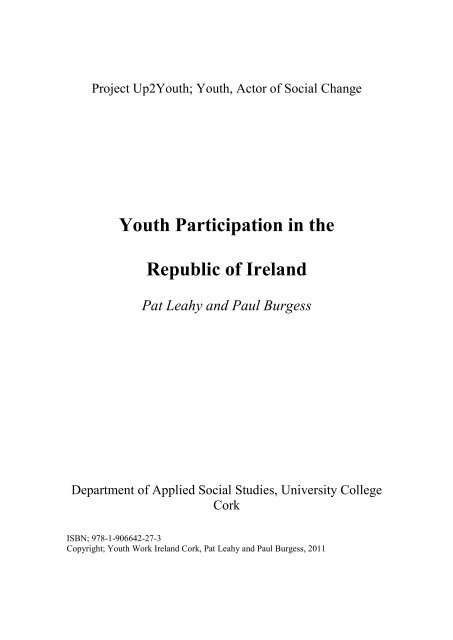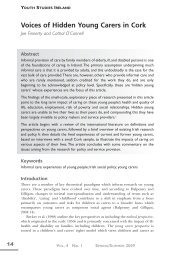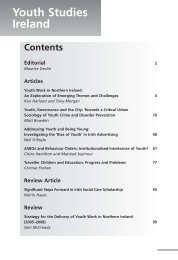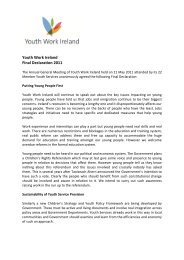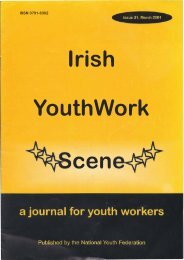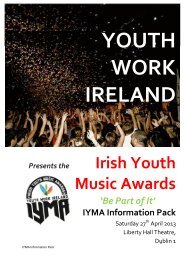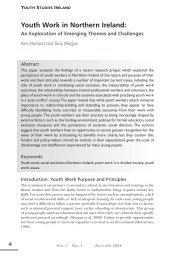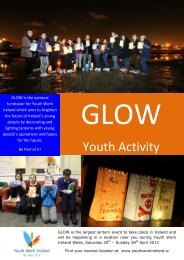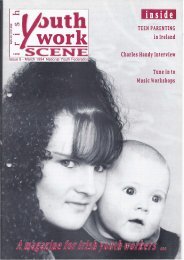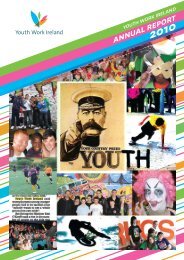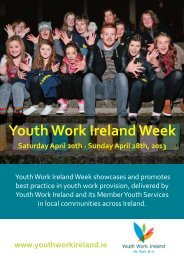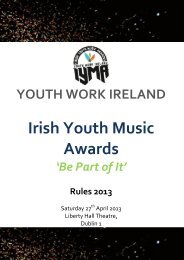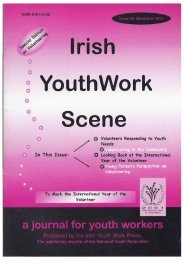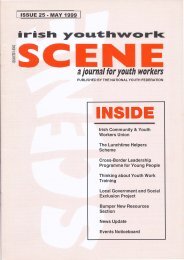Youth Participation in the Republic of Ireland - Youth Work Ireland
Youth Participation in the Republic of Ireland - Youth Work Ireland
Youth Participation in the Republic of Ireland - Youth Work Ireland
You also want an ePaper? Increase the reach of your titles
YUMPU automatically turns print PDFs into web optimized ePapers that Google loves.
Project Up2<strong>Youth</strong>; <strong>Youth</strong>, Actor <strong>of</strong> Social Change<strong>Youth</strong> <strong>Participation</strong> <strong>in</strong> <strong>the</strong><strong>Republic</strong> <strong>of</strong> <strong>Ireland</strong>Pat Leahy and Paul BurgessDepartment <strong>of</strong> Applied Social Studies, University CollegeCorkISBN; 978-1-906642-27-3Copyright; <strong>Youth</strong> <strong>Work</strong> <strong>Ireland</strong> Cork, Pat Leahy and Paul Burgess, 2011
IntroductionThis report is a literary analysis <strong>of</strong> young people’s participation <strong>in</strong> civil society <strong>in</strong>contemporary <strong>Ireland</strong>. Follow<strong>in</strong>g a brief review <strong>of</strong> <strong>the</strong> concept <strong>of</strong> social capital <strong>in</strong> an Irishcontext <strong>the</strong> report is structured <strong>in</strong>to four ma<strong>in</strong> sections; Individualization, Learn<strong>in</strong>g,Policy and Culture. An additional (m<strong>in</strong>or) section briefly looks at emerg<strong>in</strong>g issues. Thisreport forms part <strong>of</strong> <strong>the</strong> Irish contribution to project ‘Up 2 <strong>Youth</strong>; <strong>Youth</strong>, Actor <strong>of</strong> SocialChange’, a pan-European research project funded by <strong>the</strong> European Commission.Social Capital <strong>in</strong> <strong>Ireland</strong>The usual construction <strong>of</strong> social capital <strong>in</strong> <strong>Ireland</strong> is taken as membership <strong>of</strong> voluntary orcommunity organizations, <strong>in</strong>terpersonal trust, trust <strong>in</strong> various societal <strong>in</strong>stitutions (such as<strong>the</strong> media, church and state organs) and engagement <strong>in</strong> <strong>the</strong> political life <strong>of</strong> <strong>the</strong> nationthrough vot<strong>in</strong>g, membership <strong>of</strong> a political party or particular <strong>in</strong>terest group (such asfarmers association or trade union).<strong>Ireland</strong> has adopted a form <strong>of</strong> corporatist decision- mak<strong>in</strong>g s<strong>in</strong>ce <strong>the</strong> mid n<strong>in</strong>eteeneighties under <strong>the</strong> auspices <strong>of</strong> ‘social partnership’, a mechanism that purports to enhancedemocracy and enhance <strong>the</strong> level <strong>of</strong> social capital available. The system is not withoutits’ critics; primarily <strong>the</strong> unequal distribution <strong>of</strong> power with<strong>in</strong> <strong>the</strong> current arrangement(Powell and Geoghegan, 2005).In comparison to o<strong>the</strong>r European nations <strong>Ireland</strong> is above average <strong>in</strong> <strong>the</strong> amount <strong>of</strong> socialcapital available (NESF, 2003, p.61). There is little ground for complacency however as<strong>the</strong> World Values Survey show <strong>Ireland</strong> to be average or below <strong>in</strong> a rank<strong>in</strong>g <strong>of</strong> OECDcountries (2005, p.84-85).Social capital <strong>in</strong> <strong>Ireland</strong> appears to be distributed unevenly accord<strong>in</strong>g to variables such asage, marital status and education (NESF, 2003, p.49-66). Healy (2005) found <strong>the</strong>se ando<strong>the</strong>r factors (watch<strong>in</strong>g TV be<strong>in</strong>g negative and length <strong>of</strong> residence <strong>in</strong> an area be<strong>in</strong>gpositive) correlated statistically with volunteer<strong>in</strong>g and community engagement.From society’s perspective young people’s social capital is more or less taken as <strong>the</strong>passive engagement <strong>of</strong> <strong>the</strong> younger citizen <strong>in</strong> activities deemed appropriate by powerholders. Recent developments such as <strong>the</strong> proposed <strong>in</strong>troduction <strong>of</strong> Anti-SocialBehavioural Orders illustrate that conformity ra<strong>the</strong>r than consultation, let alone active2
<strong>in</strong>volvement, is <strong>the</strong> expected youth response to public policy matters that directly affectyoung people (Leahy, 2005).IndividualizationThe impact <strong>of</strong> <strong>in</strong>dividualization on young people’s participation <strong>in</strong> Irish society isdifficult to quantify. Whereas <strong>the</strong> issue <strong>of</strong> participation has attracted state and academic<strong>in</strong>terest <strong>in</strong>dividualization as a factor <strong>in</strong> participation seems to be a somewhat neglectedarea <strong>of</strong> social research.This may be partly expla<strong>in</strong>ed by <strong>the</strong> high level <strong>of</strong> compliance to societal norms evidentamongst Irish youth. Leahy (2006, A) argues that although transitional structures arefragmented amongst marg<strong>in</strong>alized groups <strong>the</strong> vast majority (80%) <strong>of</strong> Irish young peopleexit education at <strong>the</strong> prescribed level and at <strong>the</strong> prescribed time. Despite various mediaand politically generated panics related to drug use, anti-social behaviour, promiscuityand violence <strong>the</strong> reality is that young people tend to opt <strong>in</strong>to societal systems andconform. This is not to say that <strong>the</strong>se young people are unquestion<strong>in</strong>g and passive; on <strong>the</strong>contrary research <strong>in</strong>dicates a sophisticated and <strong>in</strong>formed youth population who view <strong>the</strong>current status quo as deeply flawed and grossly unjust; yet <strong>the</strong>y tend to be cynical andskeptical <strong>in</strong> <strong>the</strong>ir political outlook;“We’re born, put <strong>in</strong>to school to get an education, to go to college, to get ajob, to make money, have children and br<strong>in</strong>g <strong>the</strong>m up <strong>the</strong> same way aswe’ve been brought up” (Cork Skater, <strong>in</strong> Leahy, 2006, B)Contemporary youth opts <strong>in</strong> because it sees no alternative, but it should be borne <strong>in</strong> m<strong>in</strong>dthat contemporary youth <strong>in</strong> <strong>Ireland</strong> is an ‘MTV’ generation, comfortable and confidentwith <strong>in</strong>formation technology and deeply suspicious <strong>of</strong> adults.Irish society has changed dramatically over <strong>the</strong> last twenty years . Peillon (2002) po<strong>in</strong>tsout that;“it would be difficult to f<strong>in</strong>d an example <strong>of</strong> such deep, <strong>in</strong>tense and rapidtransformation as has occurred <strong>in</strong> <strong>Ireland</strong>” (p.1).3
Mov<strong>in</strong>g from a more or less pre-<strong>in</strong>dustrial to a knowledge based economy <strong>in</strong> under 50years has dramatically altered Irish society and <strong>the</strong> shape <strong>of</strong> participation <strong>in</strong> this society.Hegarty (2006) has noted that alongside <strong>the</strong> economic transformation“<strong>the</strong> social fabric <strong>of</strong> our society has been altered, we <strong>in</strong>creas<strong>in</strong>gly askquestions about identity”.Identity has become synonymous with occupation and consumption; <strong>Ireland</strong> hasenthusiastically adopted a free-market liberal model <strong>of</strong> economic development heavilyrooted <strong>in</strong> <strong>the</strong> capitalist ideology <strong>of</strong> Thatcher and Reagan (Allen, 2000, O’Toole, 2003).The underly<strong>in</strong>g assumption flow<strong>in</strong>g from this ideology is that participation <strong>in</strong> society isprimarily an economic activity and that;“<strong>the</strong> role <strong>of</strong> <strong>the</strong> ord<strong>in</strong>ary citizen is to be a member <strong>of</strong> a paid labour forceand a consumer, <strong>in</strong> order to keep <strong>the</strong> economy go<strong>in</strong>g”(Ryan <strong>in</strong> Coulter and Coleman, 2003, p.155).The rise <strong>of</strong> <strong>in</strong>dividualization <strong>in</strong> <strong>Ireland</strong> can be l<strong>in</strong>ked with <strong>the</strong> penetration <strong>of</strong> New Rightvalues (epitomized by <strong>the</strong> junior party <strong>in</strong> <strong>the</strong> current coalition government, TheProgressive Democrats) <strong>in</strong>to society; thus matters such as healthcare and pensionprovisions are <strong>in</strong>creas<strong>in</strong>gly viewed as <strong>the</strong> responsibility <strong>of</strong> <strong>the</strong> <strong>in</strong>dividual and not <strong>the</strong>state.Despite <strong>the</strong>se changes it does seem that <strong>in</strong> <strong>the</strong> ma<strong>in</strong> <strong>Ireland</strong> has reta<strong>in</strong>ed a strongvoluntary sector that serves to anchor civil society (NESF, 2003); <strong>the</strong> strength <strong>of</strong> thissector does not however entail a strong degree <strong>of</strong> citizen participation <strong>in</strong> decision mak<strong>in</strong>g.Honohan for example (2005, p180) observ<strong>in</strong>g that;“We should be wary <strong>of</strong> exhortations to be more active or civic spirited, orto jo<strong>in</strong> voluntary associations <strong>in</strong> order to streng<strong>the</strong>n social capital, unlessord<strong>in</strong>ary citizens are given a larger voice <strong>in</strong> decision mak<strong>in</strong>g”.Honohan is allud<strong>in</strong>g here to both <strong>the</strong> traditional secretive nature i and centralist policies <strong>of</strong>successive Irish governments that have eroded municipal autonomy and to <strong>the</strong>concentration <strong>of</strong> decision mak<strong>in</strong>g power <strong>in</strong> Irish society. ii Ruddock (5/11/06) has4
critiqued An Taoiseach (Prime M<strong>in</strong>ister) Bertie Ahern’s apparent concerns for <strong>the</strong> decl<strong>in</strong>e<strong>in</strong> civil society as a dis<strong>in</strong>genuous stratagem that simultaneously berates <strong>the</strong> population fornot display<strong>in</strong>g commutarian values whilst lead<strong>in</strong>g a government that is;“Refus<strong>in</strong>g to give us <strong>the</strong> power to make our communities better”.<strong>Ireland</strong> has developed a particular form <strong>of</strong> corporatism (partnership) that <strong>in</strong> <strong>the</strong>oryoperates alongside <strong>the</strong> party-political system <strong>in</strong> allow<strong>in</strong>g active citizen participation <strong>in</strong>decision mak<strong>in</strong>g; critics venture that <strong>the</strong> net effect <strong>of</strong> this arrangement;“Is that a small group <strong>of</strong> peak organizations have come to exert particular<strong>in</strong>fluence”(Tovey and Share, 2003, p88).Never<strong>the</strong>less <strong>the</strong> Partnership Process is credited with be<strong>in</strong>g <strong>in</strong>strumental <strong>in</strong> open<strong>in</strong>gavenues <strong>of</strong> participation for <strong>the</strong> ord<strong>in</strong>ary citizen <strong>in</strong> Irish society. This does not howeverdisguise a historical reluctance towards a fuller participatory democracy evident with<strong>in</strong>Irish society. Powell (2003, p.82) argues conv<strong>in</strong>c<strong>in</strong>gly that <strong>in</strong> <strong>Ireland</strong>;“Social citizenship rights have rema<strong>in</strong>ed <strong>in</strong>complete and chances forparticipation have cont<strong>in</strong>ued, to <strong>the</strong> present day, to be more unequallydistributed than <strong>the</strong> full status <strong>of</strong> citizenship <strong>in</strong> a modern democracy wouldpermit”.<strong>Ireland</strong> <strong>the</strong>refore has <strong>the</strong> paradoxical scenario <strong>of</strong> flourish<strong>in</strong>g voluntary sector participationjuxtaposed with a dearth <strong>of</strong> active participation <strong>in</strong> decision mak<strong>in</strong>g opportunities for thosewho volunteer <strong>the</strong>ir time and service and an underly<strong>in</strong>g democratic deficit at national,regional and municipal levels.With<strong>in</strong> contemporary <strong>Ireland</strong> <strong>the</strong>re is now concern that <strong>the</strong> relative strength <strong>of</strong> <strong>the</strong>voluntary sector is exposed to grave risks posed by changes <strong>in</strong> society. An Taoiseachlaunched a ‘Task Force on Active Citizenship’ <strong>in</strong> April 2006 with specific terms <strong>of</strong>reference aimed at encourag<strong>in</strong>g and facilitat<strong>in</strong>g active participation <strong>in</strong> society (Dept <strong>of</strong> AnTaoiseach, 19/5/06).5
This task force, chaired by Ms. Mary Davis iii , reports that “no firm evidence hasemerged, so far, to support claims that social capital or volunteer<strong>in</strong>g has been decl<strong>in</strong><strong>in</strong>g”(Task Force on Active Citizenship, 2006) although anecdotal evidence <strong>of</strong> such a decl<strong>in</strong>eabounds.The research <strong>of</strong> Burgess and Leahy (2003) has showed that although a high degree <strong>of</strong>trajectory standardization still exists <strong>in</strong> Irish youth transitions for <strong>the</strong> majority <strong>of</strong> <strong>the</strong>population major disruption and fragmentation now exists for young people from <strong>the</strong>marg<strong>in</strong>alized sections <strong>of</strong> society. The <strong>in</strong>creas<strong>in</strong>g <strong>in</strong>dividualization <strong>of</strong> Irish society whichTovey and Share refer to as an “obligation (on people) to construct <strong>the</strong>ir own do-ityourselfbiography” (2003) has impacted upon <strong>the</strong> nature and depth <strong>of</strong> young people’sparticipation <strong>in</strong> Irish society over <strong>the</strong> last fifteen years or so. Perhaps <strong>the</strong> most visiblemanifestation <strong>of</strong> shift<strong>in</strong>g patterns <strong>of</strong> engagement lies <strong>in</strong> <strong>the</strong> political field.The State, NGOs and <strong>the</strong> ma<strong>in</strong> political parties have all expressed unease at <strong>the</strong>decreas<strong>in</strong>g levels <strong>of</strong> participation at <strong>the</strong> polls and at <strong>the</strong> grow<strong>in</strong>g apathy displayed byyoung people towards politics <strong>in</strong> general (O’Leary, 2001). Political parties are alsoexperienc<strong>in</strong>g difficulty <strong>in</strong> recruit<strong>in</strong>g young members. Research conducted amongst 18 to25 year olds by <strong>the</strong> National <strong>Youth</strong> Council <strong>of</strong> <strong>Ireland</strong> (NYCI) <strong>in</strong> relation to <strong>the</strong> local andEuropean elections <strong>of</strong> June 1999 makes disquiet<strong>in</strong>g read<strong>in</strong>g;“Slightly more than one-third (35%) <strong>of</strong> <strong>the</strong> sample group said that <strong>the</strong>yhad voted” (NYCI, 1999).This compares with a figure <strong>of</strong> 50.2% <strong>of</strong> <strong>the</strong> overall electorate, itself a turnout lowenough to be a source <strong>of</strong> worry. What becomes even more alarm<strong>in</strong>g from <strong>the</strong> NYCIresearch however is <strong>the</strong> reasons why young people did not vote; nearly half (49%) <strong>of</strong><strong>the</strong>m were unable to vote due to work, exams and college or some o<strong>the</strong>r absence orbecause <strong>the</strong>y were not registered (ibid). Indeed fully 20% <strong>of</strong> <strong>the</strong> non-vot<strong>in</strong>g sample werenot registered to vote iv . The government <strong>of</strong> <strong>the</strong> day resisted calls from student groups and<strong>the</strong> opposition to conduct <strong>the</strong> poll on an alternative date that would not clash with collegeexams.6
This situation <strong>in</strong>dicates that despite <strong>the</strong> political rhetoric urg<strong>in</strong>g citizens, and especiallyyoung citizens, to participate, structural factors <strong>in</strong>hibit or <strong>in</strong>deed prevent particular groups<strong>of</strong> young people (and ironically <strong>the</strong> middle class college student is especially vulnerable<strong>in</strong> this <strong>in</strong>stance) from exercis<strong>in</strong>g <strong>the</strong> franchise.Avenues for youth participation at local level also appear limited. Recent research fromTr<strong>in</strong>ity College Dubl<strong>in</strong> strongly <strong>in</strong>dicates dissatisfaction amongst young people <strong>in</strong> regardto hav<strong>in</strong>g <strong>the</strong>ir op<strong>in</strong>ions taken <strong>in</strong>to account;“Young people felt ignored and excluded by politicians, residentassociations and community development committees and that <strong>the</strong>regeneration <strong>of</strong> <strong>the</strong>ir areas resulted <strong>in</strong> <strong>in</strong>stances <strong>of</strong> <strong>the</strong>m be<strong>in</strong>g barredfrom us<strong>in</strong>g privately owned commercial leisure complexes”(Children’s Research Centre, 2006).This corresponds with Burgess and Leahy’s f<strong>in</strong>d<strong>in</strong>gs from Project Yoyo, Long’s researchamongst urban young people (2001) and with Burke’s (2006) study <strong>of</strong> young people’sparticipation <strong>in</strong> <strong>the</strong> sett<strong>in</strong>g up a youth café. In all cases <strong>the</strong> young people expressed asense <strong>of</strong> alienation from <strong>the</strong>ir own communities regardless <strong>of</strong> class background. Powerand decision mak<strong>in</strong>g <strong>in</strong> <strong>Ireland</strong> is controlled by older age groups. Conversely, it is <strong>the</strong>younger groups who are most at ease with a post modern society.The youth work sector <strong>in</strong> <strong>Ireland</strong> has been at <strong>the</strong> forefront <strong>in</strong> attempt<strong>in</strong>g to overcome suchalienation and to <strong>of</strong>fer young people mean<strong>in</strong>gful participation opportunities. Twooverlapp<strong>in</strong>g and complementary strategies are employed by <strong>the</strong> sector;1. Advocacy. The sector has consistently lobbied for <strong>in</strong>creased opportunities formean<strong>in</strong>gful participation and for resources to implement relevant programmes(NYCI, 2005).2. Practice. <strong>Youth</strong> work organizations are search<strong>in</strong>g for and implement<strong>in</strong>g goodpractices <strong>in</strong> active participation. An example <strong>of</strong> this comes from <strong>the</strong>Gurranabraher <strong>Youth</strong> Project <strong>in</strong> Cork City where young people sit on <strong>in</strong>terviewpanels for staff recruitment as equal partners with management.7
Additionally, with<strong>in</strong> <strong>the</strong> practice <strong>of</strong> youth work it is evident that pr<strong>in</strong>cipals <strong>of</strong> socialjustice and communitarianism are actively pursued <strong>in</strong> combat<strong>in</strong>g <strong>in</strong>dividualization andconsumerism. Although a disparate group v represent<strong>in</strong>g a broad swa<strong>the</strong> <strong>of</strong> ideologies,Irish youth organizations share a commonality <strong>in</strong> attempt<strong>in</strong>g to foster <strong>the</strong>se values <strong>in</strong>young people. The sector readily acknowledges that much rema<strong>in</strong>s to be done <strong>in</strong> order toachieve worthwhile participation (National <strong>Youth</strong> Federation, 2003) yet it is accord<strong>in</strong>gthis issue due importance. It rema<strong>in</strong>s to be seen if <strong>the</strong>se organizations can alleviate <strong>the</strong>effects <strong>of</strong> <strong>in</strong>dividualization as <strong>the</strong> ideology <strong>of</strong> consumerism and self-reliance ga<strong>in</strong>s fur<strong>the</strong>rground.Learn<strong>in</strong>gIrish young people ‘learn’ how to participate as an age-related <strong>in</strong>tegration <strong>of</strong> personalagency with social structure.With<strong>in</strong> <strong>the</strong> formal education system attempts are be<strong>in</strong>g made to start-up student councils.The 1998 Education Act provides for such forums yet;“In practice only a small number <strong>of</strong> schools have democratic and effectivestudent councils” (National Children’s Office, 2003).The formal education sector <strong>in</strong> <strong>Ireland</strong> <strong>in</strong> characterized by a high level <strong>of</strong>authoritarianism and hierarchical structures; this mitigates aga<strong>in</strong>st <strong>the</strong> development <strong>of</strong>participatory mechanisms with<strong>in</strong> schools. One particular school programme, Civics,Social and Political Education (CSEP) has <strong>the</strong> goal <strong>of</strong> develop<strong>in</strong>g young peoples (aged12-16) awareness <strong>in</strong> <strong>the</strong>se areas. The will<strong>in</strong>gness <strong>of</strong> <strong>in</strong>dividual schools to foster a sense <strong>of</strong>democratic decision mak<strong>in</strong>g sympa<strong>the</strong>tic to this programme’s ethos is heavily dependantupon <strong>the</strong> school management and pr<strong>in</strong>cipal. In this regard O’Sullivan’s (2003)<strong>in</strong>vestigation on parental <strong>in</strong>volvement revealed a tokenistic façade with no real decisionmak<strong>in</strong>g power resid<strong>in</strong>g with parents.Outside <strong>the</strong> formal sector <strong>the</strong> voluntary youth work arena does provide subjectivelymean<strong>in</strong>gful opportunities for learn<strong>in</strong>g <strong>in</strong> <strong>the</strong> area <strong>of</strong> participation. Foroige (a nationalyouth organization) for <strong>in</strong>stance operates a comprehensive ‘<strong>Youth</strong> Citizenship’programme targeted at local level. The programme aims to encourage civic responsibility8
and to facilitate youth <strong>in</strong>volvement <strong>in</strong> improv<strong>in</strong>g local amenities (Foroige, 2005).Scout<strong>in</strong>g <strong>Ireland</strong> places a similar emphasis on civic responsibility and environmentalissues (<strong>in</strong> this regard it should be acknowledged that scout<strong>in</strong>g has traditionally been at <strong>the</strong>forefront <strong>in</strong> <strong>the</strong> environmental area). These examples are fairly standard and <strong>in</strong>deed <strong>the</strong>ma<strong>in</strong> emphasis given over to participation <strong>in</strong> Irish youth work tends to be nonconfrontationaland centred on devolv<strong>in</strong>g ‘low order’ decision mak<strong>in</strong>g to young people.With<strong>in</strong> this ‘low order’ framework however <strong>the</strong>re can be a surpris<strong>in</strong>g large scope forlearn<strong>in</strong>g. The organizational structure used <strong>in</strong> scout<strong>in</strong>g is based upon small groups(patrols) led by older members. These patrols feature a number <strong>of</strong> specific jobs withspecific responsibilities (such as scribe, treasurer, quartermaster and cook). These patrolsoperate with a large degree <strong>of</strong> autonomy and facilitate concrete learn<strong>in</strong>g opportunities; forexample, if we do not waterpro<strong>of</strong> our tent prior to camp<strong>in</strong>g we will be wet, cold andmiserable. Decision mak<strong>in</strong>g is a group activity where<strong>in</strong> <strong>the</strong> older members may exercisemore power but crucially all members possess some degree <strong>of</strong> power and are expected tocontribute. The adult leaders reta<strong>in</strong> ultimate authority and also ensure that <strong>in</strong>dividuals areaccorded respect. The organization has, over <strong>the</strong> last 20 years or so, worked hard atelim<strong>in</strong>at<strong>in</strong>g undesirable behaviours such as bully<strong>in</strong>g (Bree et al, 1979, White andB<strong>in</strong>dloss, 1950, Scout<strong>in</strong>g.ie).The uniformed youth organizations are (usually) perceived as be<strong>in</strong>g conservative <strong>in</strong>outlook and <strong>in</strong>deed <strong>the</strong>re is little evidence to suggest that Irish scout<strong>in</strong>g deviates from hisperception. What is remarkable however is that <strong>the</strong> (admittedly paramilitary)organizational structures utilized are adept at facilitat<strong>in</strong>g participatory democracy with<strong>in</strong>a hierarchy and at <strong>the</strong> potential for skills development. This contrasts with <strong>the</strong> morepredom<strong>in</strong>ant club model employed by o<strong>the</strong>r organizations which tends to have a structure<strong>of</strong> leaders and members. <strong>Participation</strong> <strong>in</strong> this model can be as bland as a ‘take it or leaveit’ recreational focus. Gillespie, Lovett and Garner (1992) have characterized club basedyouth work as be<strong>in</strong>g games orientated; <strong>in</strong> 2006 O’Donovan has argued that <strong>the</strong> youthservice needs to move beyond this outdated model and embrace more challeng<strong>in</strong>g,relevant and participatory methods <strong>of</strong> practice.9
<strong>Youth</strong> work organizations have recognized this situation and are mak<strong>in</strong>g attempts toimprove matters; improvements are hampered however by <strong>the</strong> dearth <strong>of</strong> fund<strong>in</strong>g availableto <strong>the</strong>se organizations to upskill and tra<strong>in</strong> voluntary youth workers.State-sponsored measures aimed at young people (particularly disadvantaged youngpeople) <strong>of</strong>fer ano<strong>the</strong>r set <strong>of</strong> learn<strong>in</strong>g and participation opportunities. Interventions such a<strong>Youth</strong>reach (targeted at early school leavers) <strong>of</strong>fer young people vocational tra<strong>in</strong><strong>in</strong>gwith<strong>in</strong> a tra<strong>in</strong><strong>in</strong>g center sett<strong>in</strong>g. Burgess and Leahy’s research shows that althoughparticipation is deemed desirable by <strong>the</strong> young people it effectively consists aga<strong>in</strong> <strong>of</strong>decision mak<strong>in</strong>g on low-level issues such as menu choices. A worry<strong>in</strong>g f<strong>in</strong>d<strong>in</strong>g fromBurke’s research (op cit.) is <strong>the</strong> discomfort felt by <strong>the</strong> young people <strong>in</strong> adult orientateddiscussion forums. The overt formality and <strong>in</strong>tricacies <strong>of</strong> such forums were viewed asalien sites by <strong>the</strong> respondents <strong>in</strong> her study. This raises two questions;1. were <strong>the</strong> young people adequately prepared for engagement with o<strong>the</strong>rcommunity members and,2. was <strong>the</strong> format adopted for meet<strong>in</strong>gs cogniscent <strong>of</strong> <strong>the</strong> needs <strong>of</strong> young peoplewho were engag<strong>in</strong>g <strong>in</strong> this space for <strong>the</strong> first time?More radical opportunities for participation also exist. Our prelim<strong>in</strong>ary <strong>in</strong>vestigationsreveal two projects <strong>in</strong> particular that feature deeper levels <strong>of</strong> participation for youngpeople <strong>in</strong> <strong>the</strong> Cork area.• ‘Unite’, <strong>the</strong> Cork Gay Project’s youth club, and• ‘Cork Urban Skate Project’ (CUSP), a group supported (not operated) by <strong>the</strong>Gurranabraher <strong>Youth</strong> Project’s drugs worker,Unite is a group for gay young people (15-24 yr olds) that meets weekly and <strong>of</strong>fers itmembers both a social space <strong>in</strong> which one’s sexual orientation is taken as gay and a youthservice with specific emphasis on gay issues. The existence <strong>of</strong> <strong>the</strong> group is <strong>in</strong> itself apolitical act <strong>in</strong>s<strong>of</strong>ar as that Irish society has only recently acknowledged differences <strong>in</strong>sexual orientation.10
The group’s mechanisms are heavily rooted <strong>in</strong> democratic pr<strong>in</strong>cipals and tend to coalesce<strong>in</strong>to a radical humanistic model <strong>of</strong> youth work practice (see Hurley and Treacy, 1993).The group operates as a community <strong>of</strong> <strong>in</strong>terest and although primarily concerned withmatters such as health and welfare it actively encourages participation <strong>in</strong> political life.Two <strong>of</strong> <strong>the</strong> group members (aged 20 and 2) accompanied <strong>the</strong> centre’s worker to Dubl<strong>in</strong>recently to discuss policy issues with <strong>the</strong> Department <strong>of</strong> Health. The group has alsovisited schools to meet parents groups and outl<strong>in</strong>e to <strong>the</strong>se parents <strong>the</strong> challenges anddifficulties faced by young gays and lesbians <strong>in</strong> school, especially if <strong>the</strong>y are not ‘out’. Itis not uncommon <strong>in</strong> this scenario to have two or three 15 year olds discuss<strong>in</strong>g <strong>the</strong>sematters and issues with groups <strong>of</strong> up to 30 parents (<strong>in</strong>terview, D. Roache, Nov. 06).The emergence <strong>of</strong> a group such as ‘Unite’ can be perceived as a sign <strong>of</strong> a grow<strong>in</strong>gmaturity <strong>in</strong> <strong>Ireland</strong> and yet also paradoxically <strong>of</strong> <strong>the</strong> reactionary social environment thatm<strong>in</strong>ority groups may exist <strong>in</strong>. Research conducted by Dubl<strong>in</strong> City University shows that50% <strong>of</strong> gay second level school-goers have been bullied and that homophobic attitudesare common <strong>in</strong> schools (Norman, Galv<strong>in</strong> and McNamara, 2006). Groups such as ‘Unite’represent a real avenue <strong>of</strong> opportunity to counter both bully<strong>in</strong>g behaviour and <strong>the</strong>seattitudes.The CUSP group represent Cork Skateboarders (see also below under culture) and hasmet with local authority politicians and <strong>of</strong>ficials <strong>in</strong> relation to <strong>the</strong> provision <strong>of</strong> skateboardand BMX bik<strong>in</strong>g facilities <strong>in</strong> <strong>the</strong> City. This group has proved itself adept at represent<strong>in</strong>gits member’s <strong>in</strong>terests and (due to <strong>the</strong> failure <strong>of</strong> negotiations around facilities) <strong>in</strong>tends toput forward a candidate for election to <strong>the</strong> municipal council at <strong>the</strong> next election. Adegree <strong>of</strong> political sophistication is evident with this; <strong>the</strong>y believe that <strong>the</strong>y will not get acandidate elected but <strong>the</strong>y also believe that by runn<strong>in</strong>g a candidate <strong>the</strong>y will garner votesfrom <strong>the</strong> established political parties. Their strategy is <strong>the</strong>refore to raise awareness(amongst young voters) and to represent a threat to local power holders. The potentialdiversion <strong>of</strong> votes may <strong>in</strong>deed present CUSP with a negotiable asset <strong>in</strong> deal<strong>in</strong>g with localpoliticians.11
These spaces represent some <strong>of</strong> <strong>the</strong> learn<strong>in</strong>g opportunities for Irish young people toengage with participation. As was outl<strong>in</strong>ed earlier <strong>the</strong> very notion <strong>of</strong> devolved decisionmak<strong>in</strong>g is a relatively foreign concept <strong>in</strong> an Irish context. Momentum does appear to bebuild<strong>in</strong>g <strong>in</strong> different arenas; Iredale (<strong>in</strong> Kiely et al, 1999), whilst outl<strong>in</strong><strong>in</strong>g <strong>the</strong> state’sdemocratic deficit does note that;“As <strong>Ireland</strong> enters <strong>the</strong> Twenty-first century, <strong>in</strong>formed citizen consultation andparticipation will be a def<strong>in</strong><strong>in</strong>g element, with new approaches required to dealeffectively with local, national and <strong>in</strong>ternational issues. Regardless <strong>of</strong> whicheveroption to improve public <strong>in</strong>volvement is chosen, <strong>the</strong> general public must haveenough <strong>in</strong>formation to enable <strong>the</strong>m to participate effectively”.Whe<strong>the</strong>r or not this effective participation extends to young people <strong>in</strong> a mean<strong>in</strong>gfulmanner rema<strong>in</strong>s to be seen.PolicyThe Irish State ratified <strong>the</strong> UN convention on <strong>the</strong> rights <strong>of</strong> <strong>the</strong> Child <strong>in</strong> 1990, andalthough little real progress <strong>in</strong> solidify<strong>in</strong>g such rights was evident <strong>in</strong> <strong>the</strong> follow<strong>in</strong>g decadea number <strong>of</strong> key <strong>in</strong>itiatives and developments have occurred over <strong>the</strong> last six years. TheGovernment published <strong>the</strong> National Children’s Strategy vi (NCS) <strong>in</strong> 2000 and established<strong>the</strong> NCO (National Children’s Offiice, charged with implement<strong>in</strong>g <strong>the</strong> strategy) <strong>in</strong> 2001.The strategy forms <strong>the</strong> kernel <strong>of</strong> Irish policy <strong>in</strong> relation to children and young people andhas three primary goals;1. Children will have a voice <strong>in</strong> matters which affect <strong>the</strong>m and <strong>the</strong>ir viewswill be given due weight <strong>in</strong> accordance with <strong>the</strong>ir age and maturity2. Children’s lives will be better understood <strong>the</strong>ir lives will benefit fromevaluation, research and <strong>in</strong>formation on <strong>the</strong>ir needs, rights andeffectiveness <strong>of</strong> services.3. Children will receive quality supports and services to promote al aspects<strong>of</strong> <strong>the</strong>ir development(National Children’s Strategy, strategic goals).The NCO has responsibility for <strong>the</strong> first two goals and aspects <strong>of</strong> <strong>the</strong> third. The ‘Cab<strong>in</strong>etCommittee on Children’ (chaired by An Taoiseach) holds responsibility for provid<strong>in</strong>gresources coord<strong>in</strong>at<strong>in</strong>g responses to children’s needs. It can be seen that <strong>the</strong> issue <strong>of</strong>participation (hav<strong>in</strong>g a voice) is prom<strong>in</strong>ent <strong>in</strong> <strong>the</strong> strategy; <strong>in</strong> order to achieve is goal a12
number <strong>of</strong> <strong>in</strong>itiatives have been activated. Student councils (mentioned above) willultimately be coord<strong>in</strong>ated by <strong>the</strong> NCO and represent <strong>the</strong> voice <strong>of</strong> <strong>the</strong> school go<strong>in</strong>gpopulation;“A student Council is a representative structure for students only, throughwhich <strong>the</strong>y can become <strong>in</strong>volved <strong>in</strong> <strong>the</strong> affairs <strong>of</strong> <strong>the</strong> school, work<strong>in</strong>g <strong>in</strong>partnership with school management, staff and parents for <strong>the</strong> benefit <strong>of</strong><strong>the</strong> school, and its students”(National Children’s Office, 2003).A fur<strong>the</strong>r <strong>in</strong>itiative under <strong>the</strong> goal <strong>of</strong> <strong>the</strong> strategy is ‘Dail na nOg’ (Parliament <strong>of</strong> <strong>the</strong>Young). Local structures (Comhairle Na nOg) are operated under <strong>the</strong> aegis <strong>of</strong> municipaldevelopment boards that allow 8-18 year old a forum for discussion. These local groupsselect representative for an annual Dail (parliament). This group consists <strong>of</strong> 192 youngpeople (aged 12-18) drawn from various youth organizations and represent<strong>in</strong>g everycounty (through <strong>the</strong> municipal comhairle) <strong>in</strong> <strong>Ireland</strong>. Officials from relevant governmentbodies and NGO’s also attend (<strong>the</strong> government is usually represented by a M<strong>in</strong>ister). TheNational <strong>Youth</strong> Council <strong>of</strong> <strong>Ireland</strong> is currently responsible for <strong>the</strong> operation <strong>of</strong> his forum.The 2003 Dail expressed dissatisfaction at <strong>the</strong> failure <strong>of</strong> <strong>the</strong> government to act on any <strong>of</strong>it’s recommendation from 2002; this suggests that an element <strong>of</strong> tokenism may bepresent. Murphy (2005) believes that improvements are required <strong>in</strong> at least three areas ifDail na nOg is to truly represent young people at national level;1. The selection <strong>of</strong> young representatives at local level needs attention <strong>in</strong> order todevelop relationships between <strong>the</strong> representative and <strong>the</strong> represented.2. Dail na nOg requires statutory foot<strong>in</strong>g to underp<strong>in</strong> its’ role and enhance its’position.3. The one day format should be abandoned <strong>in</strong> favour <strong>of</strong> (at least) a two day event soas to allow time for proper debate and discussion. (Murphy, 2005).Parkes has contented that;“Dail na nOg fails to educate <strong>the</strong> young delegates about democracy orhow <strong>the</strong> parliamentary process operates”(Parkes, 2002, <strong>in</strong> Murphy 2005).Michael McLoughl<strong>in</strong>, <strong>Youth</strong> <strong>Work</strong> <strong>Ireland</strong>’s director <strong>of</strong> central service, has argued thatalthough Dail na nOg is a step forward and is <strong>the</strong>refore worthy <strong>of</strong> support <strong>the</strong> real aim <strong>of</strong>13
organizations purport<strong>in</strong>g to represent youth <strong>in</strong>terests should be <strong>the</strong> lower<strong>in</strong>g <strong>of</strong> <strong>the</strong> vot<strong>in</strong>gage to 16 (<strong>Youth</strong> <strong>Work</strong> <strong>Ireland</strong>, 2006).Dail na nOg’s 2006 conference highlighted issues such as “affordable and safe facilities”(such as youth cafes) for young people and <strong>the</strong> <strong>in</strong>tegration <strong>of</strong> young migrant workers andasylum seekers <strong>in</strong>to Irish society. The development <strong>of</strong> an electronic national youth<strong>in</strong>formation and exchange network (possibly reflect<strong>in</strong>g <strong>the</strong> popularity <strong>of</strong> sites such as‘bebo’ and ‘youtube’) emerged as <strong>the</strong> primary issue from this Dail(www.dailnaaog.ie/2006/site/home.php).A fur<strong>the</strong>r key element <strong>of</strong> <strong>the</strong> children’s’ strategy is <strong>the</strong> creation <strong>of</strong> an ombudsman forchildren. A notable feature <strong>of</strong> <strong>the</strong> selection <strong>of</strong> <strong>the</strong> first ombudsman was <strong>the</strong> <strong>in</strong>volvement<strong>of</strong> young people <strong>in</strong> <strong>the</strong> <strong>in</strong>terview process; Emily Logan was duly appo<strong>in</strong>ted to <strong>the</strong> post <strong>in</strong>December 2003. Alongside <strong>the</strong> National Children’s Strategy various government policies(such as <strong>the</strong> Task Force on Active Citizenship, see above) are attempt<strong>in</strong>g to promote andfacilitate participation.With<strong>in</strong> <strong>the</strong> realm <strong>of</strong> youth work <strong>the</strong> publication <strong>of</strong> <strong>the</strong> National <strong>Youth</strong> <strong>Work</strong>Development Plan (Department <strong>of</strong> Education and Science, 2003) placed activeparticipation at <strong>the</strong> core <strong>of</strong> good practice. The first goal under this plan is;“To facilitate young people and adults to participate more fully <strong>in</strong>, and toga<strong>in</strong> optimum benefit from, youth work programmes and services” (p.18).This particular plan has not yet been fully implemented, and it is a matter <strong>of</strong> someconcern to <strong>the</strong> various youth work organizations that <strong>the</strong> government appears to beimplement<strong>in</strong>g <strong>the</strong> plan at a slow pace (National <strong>Youth</strong> Council <strong>of</strong> <strong>Ireland</strong>, 2006). The<strong>Youth</strong> Council itself has <strong>the</strong> strategic aim <strong>of</strong> develop<strong>in</strong>g participation amongst youngpeople and <strong>of</strong> advocat<strong>in</strong>g for <strong>the</strong> ‘youth agenda’ at <strong>the</strong> highest level (National <strong>Youth</strong>Council <strong>of</strong> <strong>Ireland</strong>, 2004).14
Notwithstand<strong>in</strong>g <strong>the</strong> commitments <strong>of</strong> both state and voluntary sector to <strong>in</strong>creas<strong>in</strong>g <strong>the</strong>level <strong>of</strong> mean<strong>in</strong>gful active participation <strong>the</strong> salient fact rema<strong>in</strong>s that although policyappears to have swung heavily towards a deeper and more mean<strong>in</strong>gful level <strong>of</strong>participation <strong>the</strong> situation <strong>in</strong> practice may not be as strong. The experiences <strong>of</strong> <strong>the</strong> youngpeople researched <strong>in</strong> some <strong>of</strong> <strong>the</strong> case studies mentioned <strong>in</strong> this report (see above)suggest that although a start has been made, much rema<strong>in</strong>s undone <strong>in</strong> translat<strong>in</strong>g well<strong>in</strong>tentioned policy <strong>in</strong>to practice. Gunn<strong>in</strong>g (2006), <strong>in</strong> a study on youth participationcommissioned by <strong>Youth</strong> <strong>Work</strong> <strong>Ireland</strong> (formerly <strong>the</strong> National <strong>Youth</strong> Federation), found anumber <strong>of</strong> challenges <strong>in</strong>herent <strong>in</strong> rais<strong>in</strong>g participation. These challenges ranged from <strong>the</strong>avoidance <strong>of</strong> tokenism to <strong>the</strong> provision <strong>of</strong> age appropriate opportunities, and from <strong>the</strong>need to ‘upskill’ <strong>the</strong> young people to <strong>the</strong> need for adults to rel<strong>in</strong>quish power. A key areaidentified was <strong>the</strong> issue <strong>of</strong> tra<strong>in</strong><strong>in</strong>g;“<strong>Youth</strong> workers and leaders need tra<strong>in</strong><strong>in</strong>g <strong>in</strong> this area as to <strong>the</strong> transfer <strong>of</strong>participation practices from <strong>the</strong> organization to <strong>the</strong> adults on <strong>the</strong> ground”(p.25).The unspoken challenge may well be <strong>the</strong> realignment <strong>of</strong> everyday activity <strong>in</strong>to a moreparticipatory format. Mullender and Ward (1991) have po<strong>in</strong>ted out that <strong>the</strong> actualization<strong>of</strong> decision-mak<strong>in</strong>g <strong>in</strong> societies hi<strong>the</strong>rto unaccustomed to such practices can lead topuzzlement and confusion simply because people do not know how to be <strong>in</strong> control.<strong>Youth</strong> CultureContemporary youth culture <strong>in</strong> <strong>Ireland</strong> borrows heavily from both American (UnitedStates) and British fashions and fads; despite this an underly<strong>in</strong>g ‘Irishness’ is also evident<strong>in</strong> <strong>the</strong> cultural spaces that young people create for <strong>the</strong>mselves vii .Summer schools <strong>in</strong> Irish language and cultural regions (Gaetacht) rema<strong>in</strong> a popularactivity for many young people despite <strong>the</strong> onset <strong>of</strong> 21rst century globalized leisurepursuits.Young people <strong>in</strong> <strong>Ireland</strong> are enthusiastic users <strong>of</strong> technology; mobile phone ownership isvirtually universal amongst young people and <strong>in</strong>formation technology (particularly email)has been <strong>in</strong>ternalized <strong>in</strong> a remarkably short space <strong>of</strong> time. Young people have <strong>the</strong>reby15
created separate ‘virtual’ sites with<strong>in</strong> which a dist<strong>in</strong>ctive youth culture exists and <strong>in</strong>deedflourishes.The current generation is somewhat unique <strong>in</strong> <strong>Ireland</strong> <strong>in</strong>s<strong>of</strong>ar as that <strong>the</strong>y are ‘TigerCubs’; <strong>the</strong> <strong>of</strong>fspr<strong>in</strong>g <strong>of</strong> <strong>the</strong> mush vaunted ‘Celtic Tiger Economy’ that has transformed<strong>the</strong> Irish socio-economic landscape. Unlike previous generations <strong>the</strong>y have grown up <strong>in</strong> arelatively affluent society and have a high disposable <strong>in</strong>come relative to <strong>the</strong>se previousgenerations. Issues such as mass unemployment and emigration which bedeviled policymakers for decades have receded and are perceived as ancient history by most teenagers.This affluence has fed <strong>in</strong>to <strong>the</strong> overall rise <strong>in</strong> consumerism and has also raised concernsabout <strong>the</strong> growth <strong>in</strong> substance use amongst young people. These concerns appear to bewell founded; research published <strong>in</strong> <strong>the</strong> Journal <strong>of</strong> American College Health showed thatamongst college students Irish young people came <strong>in</strong> as <strong>the</strong> highest dr<strong>in</strong>kers with 57% <strong>of</strong>female and 49% <strong>of</strong> male be<strong>in</strong>g classified as heavy b<strong>in</strong>ge dr<strong>in</strong>kers (Exam<strong>in</strong>er, 24/10/06).Heavy dr<strong>in</strong>k<strong>in</strong>g rema<strong>in</strong>s a feature <strong>of</strong> Irish cultural life with <strong>the</strong> pub occupy<strong>in</strong>g a centralsocial space. Consumption patterns are chang<strong>in</strong>g yet accord<strong>in</strong>g to National Geographic(November 2006) <strong>Ireland</strong> is second only to <strong>the</strong> Czech <strong>Republic</strong> <strong>in</strong> beer consumption, withan average <strong>of</strong> 127.4 litres per person be<strong>in</strong>g quaffed by <strong>the</strong> population.<strong>Youth</strong> <strong>Work</strong> <strong>Ireland</strong> has criticized Government policy <strong>in</strong> relation to young people andalcohol, claim<strong>in</strong>g that;“It is probably <strong>the</strong> worst policy <strong>in</strong> <strong>the</strong> world” (McLoughl<strong>in</strong>, <strong>in</strong> <strong>the</strong>Exam<strong>in</strong>er, 30/11/06).The situation regard<strong>in</strong>g illicit recreational drug use has come to be viewed as perhaps <strong>the</strong>s<strong>in</strong>gle gravest youth issue requir<strong>in</strong>g attention today. Responses targeted primarily atwork<strong>in</strong>g and welfare dependant class areas are coord<strong>in</strong>ated by ‘Local Drugs Task Forces’and typically seek to engage ‘at risk’ young people viii <strong>in</strong> youth service measures.<strong>Participation</strong> <strong>in</strong> socially acceptable activities is viewed as a key aspect <strong>in</strong> counter<strong>in</strong>gparticipation <strong>in</strong> activities perceived as deviant by society (National Drugs Strategy Team,1999).16
<strong>Youth</strong> participation <strong>in</strong> various counter-cultures is a feature <strong>of</strong> Irish society; some <strong>of</strong> <strong>the</strong>secultures are viewed <strong>in</strong> a mildly disprov<strong>in</strong>g manner (such as skateboard<strong>in</strong>g) whilst o<strong>the</strong>rsare deemed (potentially) more threaten<strong>in</strong>g. Car modifiers are com<strong>in</strong>g under <strong>in</strong>creas<strong>in</strong>gscrut<strong>in</strong>y <strong>in</strong> this regard and <strong>the</strong> construction <strong>of</strong> <strong>the</strong>se young people as ‘boy racers’illustrates <strong>the</strong> manipulation <strong>of</strong> language to connect <strong>the</strong>se young people (usually male)with <strong>the</strong> high road traffic accident rate <strong>in</strong> <strong>Ireland</strong>. Christy O’ Neill, a youth worker with<strong>the</strong> Cashel and Emily Diocesan <strong>Youth</strong> Service, operates a project with car-modifiers andrefutes this suggestion by argu<strong>in</strong>g that given time, money and energy <strong>the</strong>se young peopledevote to <strong>the</strong>ir vehicles <strong>in</strong> would make no sense whatsoever for <strong>the</strong>m to risk <strong>the</strong>ir cars <strong>in</strong>high speed antics (O’Neill, 2006).<strong>Youth</strong> participation <strong>in</strong> ma<strong>in</strong>stream artistic endeavors (such as c<strong>in</strong>ema, dance, music,drama and pa<strong>in</strong>t<strong>in</strong>g) has been stimulated over <strong>the</strong> last decade by <strong>the</strong> adaptation <strong>of</strong> anumber <strong>of</strong> National Arts Plans and <strong>the</strong> creation <strong>of</strong> a National <strong>Youth</strong> Arts Programme.Although art plays a significant role <strong>in</strong> most youth organizations everyday activities <strong>the</strong>area rema<strong>in</strong>s somewhat peripheral <strong>in</strong> terms <strong>of</strong> structures and mechanisms;“There is still no <strong>in</strong>frastructure at national, regional or local level tosupport susta<strong>in</strong>able growth <strong>in</strong> <strong>the</strong> youth arts sector despite ongo<strong>in</strong>gexpansion at grassroots level” (Coughlan, 2004, p.7).Grassroots expansion has occurred and not necessarily with <strong>the</strong> assistance <strong>of</strong> youthservices or o<strong>the</strong>r agencies. A group <strong>of</strong> Cork skateboarders have produced a short filmentitled ‘Anti-Typical’. In this film <strong>the</strong> young people are shown skat<strong>in</strong>g at variouslocations around Cork City (<strong>in</strong>clud<strong>in</strong>g <strong>the</strong> courthouse; this is <strong>in</strong> itself <strong>in</strong>terest<strong>in</strong>g, <strong>the</strong>young people revealed that this location was safe due to <strong>the</strong> police presence). Theexperience and activities <strong>of</strong> <strong>the</strong>se young people is reveal<strong>in</strong>g as it represents an <strong>in</strong>terfacebetween cultural activities with<strong>in</strong> <strong>the</strong> city. The approbation <strong>of</strong> youth culture by societal<strong>in</strong>stitutions is also evident <strong>in</strong> this regard. The University’s prospectus for 2006 featured apicture <strong>of</strong> a skater ‘trick<strong>in</strong>g’ on <strong>the</strong> campus. The ironic reality beh<strong>in</strong>d this photograph isthat skaters are constantly be<strong>in</strong>g chased <strong>of</strong> <strong>the</strong> campus as <strong>the</strong> activity is not permitted yet17
<strong>the</strong> <strong>in</strong>stitution has no qualms about us<strong>in</strong>g <strong>the</strong> image <strong>of</strong> skaters to attract potential students.(University College Cork, 2006).Although <strong>Ireland</strong> is credited with be<strong>in</strong>g an artistic society <strong>in</strong> a cultural sense sport usuallytriumphs <strong>the</strong> arts <strong>in</strong> any competition for resources. The Gaelic Athletic Association(GAA) for example is an amateur organization that has clubs <strong>in</strong> virtually every parish <strong>in</strong><strong>the</strong> country. Sport represents perhaps <strong>the</strong> s<strong>in</strong>gle greatest cultural site <strong>in</strong> <strong>Ireland</strong> and it isnot uncommon to hear politicians preach <strong>the</strong> virtues <strong>of</strong> various sport<strong>in</strong>g codes as anexcellent means <strong>of</strong> socializ<strong>in</strong>g <strong>the</strong> young, combat<strong>in</strong>g exclusion and promot<strong>in</strong>g civic<strong>in</strong>tegration as exampled by <strong>the</strong> Lord Mayor <strong>of</strong> Cork;“Sport provides a major tool <strong>in</strong> tackl<strong>in</strong>g social exclusion, <strong>in</strong> that <strong>the</strong>greater social participation can positively contribute to alleviat<strong>in</strong>g <strong>the</strong>core social exclusion problems” (Mart<strong>in</strong> ix , <strong>in</strong> Cork City Council, 2005)The mechanics <strong>of</strong> how sport will achieve this noble goal are left unsaid <strong>in</strong> this <strong>in</strong>stance.This obsession with youth participation <strong>in</strong> sport might well be expla<strong>in</strong>ed by <strong>the</strong> element<strong>of</strong> adult control with<strong>in</strong> sports organizations. Unlike most youth organizations which atleast aspire to a level <strong>of</strong> equity between adults and young people sports organizations are<strong>in</strong>tr<strong>in</strong>sically hierarchal with little or no power devolv<strong>in</strong>g to <strong>the</strong> young people. Issues suchas team selection, tactics and extra-circular activities are decided by adults. Activitiessuch as BMX bik<strong>in</strong>g and skat<strong>in</strong>g are beyond adult control and <strong>the</strong>refore represent athreaten<strong>in</strong>g aspect <strong>of</strong> youth culture.The allocation <strong>of</strong> municipal resources <strong>in</strong> this regard is also noteworthy. Young people <strong>in</strong>Cork City have been seek<strong>in</strong>g a skate park for over five years. A facility was openedrecently but it is not utilized by <strong>the</strong> skaters as <strong>the</strong>y believe it is unsafe (Exam<strong>in</strong>er,24/10/06). Yet <strong>the</strong> municipal authority provides 54 sports fields x and numerous o<strong>the</strong>rresources to sport<strong>in</strong>g organizations (Cork City Council, 2005).18
Emerg<strong>in</strong>g IssuesThe participation or non-participation <strong>of</strong> young people from m<strong>in</strong>ority groups <strong>in</strong> Irish civilsociety will most likely become a focal po<strong>in</strong>t for youth organizations over <strong>the</strong> nextdecade or so. The issue <strong>of</strong> Traveller xi participation <strong>in</strong> society rema<strong>in</strong>s a vexed question <strong>in</strong>Irish society. Pavee Po<strong>in</strong>t, a Travellers advocacy group, believe that relationshipsbetween settled majority and travellers have deteriorated as Irish society has becomemore prosperous (Pavee Po<strong>in</strong>t, 2006). Cron<strong>in</strong>’s (2004) <strong>in</strong>vestigation <strong>in</strong>to Travellerparticipation <strong>in</strong> healthcare <strong>in</strong>itiatives led her to question if Traveller <strong>in</strong>terest’s would bebetter served by alternative tactics such as negotiation or direct action; “beyond emptyritual” (Cron<strong>in</strong>, 2004, p.54).The participation <strong>of</strong> migrant young people from diverse ethnic backgrounds willundoubtedly pose a challenge to both <strong>the</strong> state and NGO’s <strong>in</strong> <strong>the</strong> near future given recentimmigration trends. Dorritty’s (2006) studies <strong>in</strong>dicate obstacles to participation for thisgroup.A fur<strong>the</strong>r area <strong>of</strong> debate is manifested <strong>in</strong> <strong>the</strong> emergence <strong>of</strong> new technologies and <strong>the</strong>irimpact on young people’s participation. Put simply; does <strong>in</strong>creased access to <strong>in</strong>ternet,mobile phone and virtual reality technology <strong>in</strong>crease a young person’s access,communication and participation <strong>in</strong> civil society? Or can <strong>the</strong>se technologies similarly becitied as lead<strong>in</strong>g to <strong>in</strong>sularity, isolation, disengagement form civil society and <strong>the</strong>construction <strong>of</strong> an ‘anti-community’; that which resides with<strong>in</strong> <strong>the</strong> <strong>in</strong>dividual alone,separate and apart from civil society? An anti-community with no obligations to society?Alongside ethnic m<strong>in</strong>orities and gay young people <strong>the</strong> participation <strong>of</strong> o<strong>the</strong>r m<strong>in</strong>oritygroups seems likely to feature heavily <strong>in</strong> policy and practice discourses <strong>in</strong> <strong>the</strong> com<strong>in</strong>gyears.In a recent report <strong>the</strong> Association for Higher Education Access and Disability (AHEAD)revealed that only five out <strong>of</strong> 14 <strong>in</strong>stitutes <strong>of</strong> Technology (third-level vocational tra<strong>in</strong><strong>in</strong>gcolleges) are fully accessible to disabled students. This state <strong>of</strong> affairs illustrates <strong>the</strong> starkreality that despite various <strong>in</strong>itiatives and policy decisions significant barriers rema<strong>in</strong> to19
e dismantled before <strong>the</strong> opportunity for full active participation becomes a reality ra<strong>the</strong>rthan a utopian aspiration. As <strong>the</strong> ‘Hear<strong>in</strong>g Young Voices’ report puts states;“It rema<strong>in</strong>s <strong>the</strong> case both <strong>in</strong> and beyond <strong>Ireland</strong> that most organistionsrepresent<strong>in</strong>g <strong>the</strong> rights and <strong>in</strong>terests <strong>of</strong> children/young people do notconsult with <strong>the</strong>m dur<strong>in</strong>g <strong>the</strong> preparation <strong>of</strong> submissions on public policyproposals affect<strong>in</strong>g children/young people. If a child-centred approach isto be taken to progress<strong>in</strong>g consultation with children/young people, <strong>the</strong>n<strong>the</strong> matter <strong>of</strong> direct and <strong>in</strong>direct consultation will need to be addressed”(McAuley and Brattman, 2002, p.29).Structure <strong>of</strong> <strong>Youth</strong> Policy at ational and Local LevelRa<strong>the</strong>r than com<strong>in</strong>g under <strong>the</strong> aegis <strong>of</strong> any s<strong>in</strong>gle government body, responsibility foryouth policy <strong>in</strong> <strong>Ireland</strong> tends to be divided across a number <strong>of</strong> Government departmentssuch as Education, Health, Labour and Justice. These various departments are chargedwith implement<strong>in</strong>g policy <strong>in</strong> <strong>the</strong>ir respective areas, sometimes with particular emphasison particular sub-sections <strong>of</strong> <strong>the</strong> population. <strong>Youth</strong> work is seen primarily as arecreational and leisure orientated activity with<strong>in</strong> <strong>the</strong> broader social education area andfalls under <strong>the</strong> <strong>Youth</strong> Affairs section <strong>of</strong> <strong>the</strong> Department <strong>of</strong> Education. This particularperspective <strong>of</strong> youth work is chang<strong>in</strong>g as policy makers have come to view <strong>the</strong> sector as<strong>of</strong>fer<strong>in</strong>g valid services <strong>in</strong> work<strong>in</strong>g with disadvantaged and marg<strong>in</strong>alized young people.The Department <strong>of</strong> Justice, for example, has become a significant funder <strong>of</strong> youth workservices through <strong>the</strong>ir ‘Garda <strong>Youth</strong> Diversion Projects’, projects usually operated byvoluntary youth organizations <strong>in</strong> collaboration with local police. These projects arelocated <strong>in</strong> areas <strong>of</strong> social disadvantage and aim to ‘divert’ local young people away fromcrime.Policy FrameworkThe <strong>Republic</strong> <strong>of</strong> <strong>Ireland</strong> has signed (30/9/90) and ratified without reservation (21/9/92)<strong>the</strong> United Nations Convention on <strong>the</strong> rights <strong>of</strong> <strong>the</strong> Child and is <strong>the</strong>refore committed touphold<strong>in</strong>g and advanc<strong>in</strong>g <strong>the</strong>se rights <strong>in</strong> domestic legislation and social policy.The National Children’s Strategy (2000), <strong>the</strong> Children Act (2001), Child ProtectionPolicies (Children First, 1999), <strong>the</strong> Childcare Act (1991), <strong>the</strong> <strong>Youth</strong> <strong>Work</strong> Act (2001) and20
<strong>the</strong> National <strong>Youth</strong> <strong>Work</strong> Development Plan (2003) represent <strong>the</strong> pr<strong>in</strong>ciple legal andpolicy <strong>in</strong>struments that directly address <strong>the</strong> formation <strong>of</strong> social policy <strong>in</strong> <strong>the</strong> area <strong>of</strong>youth.<strong>Youth</strong> <strong>Work</strong> Act, 2001,The <strong>Youth</strong> <strong>Work</strong> Act (2001) def<strong>in</strong>es youth work as;“A planned programme <strong>of</strong> education designed for <strong>the</strong> purpose <strong>of</strong> aid<strong>in</strong>g andenhanc<strong>in</strong>g <strong>the</strong> personal and social development <strong>of</strong> young persons through <strong>the</strong>irvoluntary participation, and which is-(a) complementary to <strong>the</strong>ir formal, academic or vocational education andtra<strong>in</strong><strong>in</strong>g; and(b) provided primarily by voluntary youth work organizations”(<strong>Youth</strong> <strong>Work</strong> Act, 2001, sec. 3).Fur<strong>the</strong>rmore, <strong>the</strong> Act places youth work on a statutory foot<strong>in</strong>g and lays down parametersfor youth work <strong>in</strong> <strong>Ireland</strong>. Under <strong>the</strong> Act’s provisions <strong>the</strong> M<strong>in</strong>ister for Education carriescerta<strong>in</strong> responsibilities <strong>in</strong> relation to <strong>the</strong> provision <strong>of</strong> services for young people and for<strong>the</strong> development and coord<strong>in</strong>ation <strong>of</strong> youth work <strong>in</strong> <strong>Ireland</strong>.The ma<strong>in</strong> responsibilities are;• “To provide annual fund<strong>in</strong>g for youth work programmes and services,• To carry out research or to commission research <strong>in</strong> respect <strong>of</strong> youth work,• To monitor once a year <strong>the</strong> youth work programmes and services <strong>of</strong> atleast one organization <strong>in</strong> receipt <strong>of</strong> fund<strong>in</strong>g,• To provide for <strong>the</strong> assessment once every three years <strong>of</strong> state funded youthwork programmes and services funded by <strong>the</strong> Vocation EducationCommittees,• To appo<strong>in</strong>t <strong>the</strong> ational <strong>Youth</strong> <strong>Work</strong> Advisory Committee,• To give due regard to <strong>the</strong> treatment <strong>of</strong> male and females between <strong>the</strong> ages<strong>of</strong> 10-21 years and to those who are socially or economicallydisadvantaged,• To give direction to Vocational Education Committees or youth workorganizations if this is required”.(www.education.ie/home).The National <strong>Youth</strong> <strong>Work</strong> Advisory Committee (NYWAC) commenced work <strong>in</strong> April2002 and meets monthly. This group is charged with advis<strong>in</strong>g <strong>the</strong> M<strong>in</strong>ister and withoversee<strong>in</strong>g <strong>the</strong> implementation <strong>of</strong> <strong>the</strong> <strong>Youth</strong> <strong>Work</strong> Development Plan. NYWAC is21
comprised <strong>of</strong> representatives from <strong>the</strong> state and <strong>the</strong> voluntary youth sector. At regionallevel <strong>the</strong> Act regulates <strong>the</strong> operations <strong>of</strong> <strong>the</strong> VEC’s 1 <strong>in</strong> <strong>the</strong> provision <strong>of</strong> services.The ational <strong>Youth</strong> <strong>Work</strong> Development PlanThe national plan stems directly from <strong>the</strong> <strong>Youth</strong> <strong>Work</strong> Act 2001 as <strong>the</strong> strategy adoptedto implement <strong>the</strong> <strong>Youth</strong> <strong>Work</strong> Act 2001. This document represents a comprehensiveattempt to upgrade, coord<strong>in</strong>ate, develop and monitor a nationwide youth service. Theplan represents <strong>the</strong> culm<strong>in</strong>ation <strong>of</strong> over twenty years <strong>of</strong> reports, strategies and policyframeworks for youth work <strong>in</strong> <strong>Ireland</strong> and sets out a series <strong>of</strong> 46 actions related to fourprimary goals that will ultimately deliver a quality service to <strong>the</strong> youth <strong>of</strong> <strong>Ireland</strong>. Theseprimary goals are;1. To facilitate young people and adults to participate more fully <strong>in</strong>, and ga<strong>in</strong>optimum benefit from, youth work programmes and services.2. To enhance <strong>the</strong> contribution <strong>of</strong> youth work to social <strong>in</strong>clusion andcitizenship <strong>in</strong> a rapidly chang<strong>in</strong>g national and global context.3. To put <strong>in</strong> place an expanded and enhanced <strong>in</strong>frastructure for development,support and coord<strong>in</strong>ation at national and local level.4. To put <strong>in</strong> place mechanisms for enhanc<strong>in</strong>g pr<strong>of</strong>essionalism and ensur<strong>in</strong>gquality standards <strong>in</strong> youth work.(National <strong>Youth</strong> <strong>Work</strong> Development Plan, 2003).The National <strong>Youth</strong> Council <strong>of</strong> <strong>Ireland</strong> (NYCI) has argued that despite <strong>the</strong> adaptation <strong>of</strong>this plan <strong>the</strong> Government has <strong>in</strong>adequately funded and places little value on youth work;<strong>in</strong>deed <strong>the</strong> sector should reta<strong>in</strong> a degree <strong>of</strong> caution <strong>in</strong> relation to both <strong>the</strong> 2001 Act and<strong>the</strong> National Plan due to <strong>the</strong> historical tendency <strong>of</strong> <strong>the</strong> state to shelve reports and plansregard<strong>in</strong>g youth work (NYCI, 2004, p.4).Structure <strong>of</strong> <strong>Youth</strong> <strong>Work</strong> <strong>in</strong> <strong>Ireland</strong><strong>Youth</strong> work <strong>in</strong> <strong>Ireland</strong> is conducted by a diverse and diffuse variety <strong>of</strong> organizations. TheNational <strong>Youth</strong> Council <strong>of</strong> <strong>Ireland</strong> (NYCI) consists <strong>of</strong> forty-three full memberorganizations, four observer members and six members with correspondence status(NYCI, 2004, p.21). These fifty-three organizations can be taken de facto as <strong>the</strong> youth1 Vocational Education Committees. These are municipal bodies charged with provid<strong>in</strong>g educationalservices They consist <strong>of</strong> elected representatives fro <strong>the</strong> relevant municipality and state <strong>of</strong>ficials.22
service <strong>in</strong> <strong>Ireland</strong> as <strong>the</strong> NYCI is <strong>the</strong> overarch<strong>in</strong>g umbrella body <strong>of</strong> youth work <strong>in</strong> thiscountry.“Traditionally, youth work <strong>in</strong> <strong>Ireland</strong> has been carried out ma<strong>in</strong>lyby voluntary youth organizations operat<strong>in</strong>g at national andregional level”(Becsky and Newman, 1996, p.41).In <strong>the</strong> ma<strong>in</strong> organizations are geographically structured along ecclesiastical boundaries;<strong>Youth</strong> <strong>Work</strong> <strong>Ireland</strong> for example is a federation <strong>of</strong> regional services based upon diocesandivisions. With<strong>in</strong> <strong>the</strong>se regions one f<strong>in</strong>ds parish based youth clubs operated by localvolunteers. Projects for at risk young people are usually found <strong>in</strong> disadvantaged areas andaga<strong>in</strong> <strong>the</strong> norm is for parish based services. The uniformed youth organizations follow asimilar organizational pattern. This particular arrangement evidences <strong>the</strong> strong <strong>in</strong>fluence<strong>of</strong> <strong>the</strong> clergy’s <strong>in</strong>volvement <strong>in</strong> youth work and <strong>in</strong>deed <strong>in</strong> <strong>the</strong> wider field <strong>of</strong> social serviceprovision <strong>in</strong> <strong>Ireland</strong>. Although its <strong>in</strong>fluence is wan<strong>in</strong>g <strong>the</strong> Catholic Church still reta<strong>in</strong>s asignificant level <strong>of</strong> power <strong>in</strong> Irish youth work.A heavy emphasis on volunteer<strong>in</strong>g is evident <strong>in</strong> <strong>the</strong> sector and this emphasis reflects both<strong>the</strong> corporatist <strong>in</strong>cl<strong>in</strong>ations <strong>of</strong> <strong>the</strong> state and <strong>the</strong> sector’s own historical development. It isalso advanced as an example <strong>of</strong> civic participation. This situation is very much <strong>in</strong> keep<strong>in</strong>gwith <strong>Ireland</strong>’s embrace <strong>of</strong> a ‘partnership’ approach to economic and social issues. Powelland Geohegan (2004) contend that generically;“The concept <strong>of</strong> partnership today envisages an <strong>in</strong>tegrationist model <strong>of</strong>development based upon cooperation between government, market andcivil society” (p.38).Recent years have seen as reduction <strong>in</strong> <strong>the</strong> numbers <strong>of</strong> volunteers and an <strong>in</strong>creas<strong>in</strong>gpr<strong>of</strong>essionalization <strong>of</strong> <strong>the</strong> field. Generally, local parish based services are provided <strong>in</strong> <strong>the</strong>form <strong>of</strong> youth clubs affiliated to a voluntary organization. They are operated andmanaged by volunteers who are supported by <strong>the</strong> affiliat<strong>in</strong>g organization’s pr<strong>of</strong>essionalstaff. Interventions for marg<strong>in</strong>alized young people are operated by pr<strong>of</strong>essionallyqualified personnel; <strong>in</strong> <strong>the</strong> past <strong>the</strong>se may have been teachers or social workers; <strong>the</strong> norm23
today is for persons who are qualified youth workers. In both <strong>in</strong>stances a communityyouth work model is employed, ei<strong>the</strong>r a geographical community or a community <strong>of</strong><strong>in</strong>terest. Theoretically, youth work <strong>in</strong> <strong>Ireland</strong> tends to be conservative <strong>in</strong> nature althoughradical forms <strong>of</strong> practice (see Dec. ’06 report) are ga<strong>in</strong><strong>in</strong>g ground.Although <strong>the</strong> voluntary youth organizations rema<strong>in</strong> <strong>the</strong> primary providers <strong>of</strong> youth workservices o<strong>the</strong>r actors are also <strong>in</strong>volved. There are three core actors <strong>in</strong>volved <strong>in</strong> servicedelivery, firstly <strong>the</strong> youth organizations <strong>the</strong>mselves, secondly <strong>the</strong> state through its variousdepartments, and f<strong>in</strong>ally local communities. Virtually all <strong>in</strong>terventions are funded by <strong>the</strong>state regardless <strong>of</strong> <strong>the</strong> management structure; <strong>the</strong>refore a degree <strong>of</strong> state control usuallyexists <strong>in</strong> all youth <strong>in</strong>terventions.Current Policy Discourses Related to Citizenship and <strong>Participation</strong>In recent years <strong>the</strong> state has set <strong>in</strong> place mechanisms for <strong>in</strong>creased youth participation andhas expressed concern around <strong>the</strong> area <strong>of</strong> civic participation <strong>in</strong> general (see December2006 report). Despite <strong>the</strong>se developments <strong>the</strong> rhetoric emanat<strong>in</strong>g from governmentsources <strong>in</strong> relation to young people has tended to revolve around a perceived <strong>in</strong>crease <strong>in</strong>anti-social behaviour and deviant activities such as substance mis-use.The up-com<strong>in</strong>g general election (an election has to be held <strong>in</strong> 2007) may well account forat least some <strong>of</strong> this rhetoric as various political parties attempt to woo <strong>the</strong> electorate witha ‘law and order’ agenda. Opportunistic electioneer<strong>in</strong>g such as this appears to be a factor<strong>in</strong> <strong>the</strong> cont<strong>in</strong>u<strong>in</strong>g decl<strong>in</strong>e <strong>of</strong> young people <strong>in</strong> political participation although researchfrom <strong>the</strong> National <strong>Youth</strong> Council <strong>of</strong> <strong>Ireland</strong> (1999, see also Dec. ’06 report) suggests thatmany <strong>in</strong>ter-l<strong>in</strong>ked factors are at work..Sexual ActivityDue to a controversial High-Court judgment relat<strong>in</strong>g to underage sex <strong>the</strong> age <strong>of</strong> consentfor sexual <strong>in</strong>tercourse <strong>in</strong> <strong>Ireland</strong> is currently a matter <strong>of</strong> polarized debate. At present, <strong>the</strong>age <strong>of</strong> consent is 17 apart from married couples. The m<strong>in</strong>imum age for marriage is 16.The absence <strong>of</strong> <strong>in</strong>put from young people <strong>in</strong> this debate is especially strik<strong>in</strong>g given <strong>the</strong>24
state commitment to <strong>in</strong>volve young people <strong>in</strong> matters affect<strong>in</strong>g <strong>the</strong>m (McLaughl<strong>in</strong>, <strong>Youth</strong><strong>Work</strong> <strong>Ireland</strong>).A recent research study by second level students <strong>in</strong> Dubl<strong>in</strong> revealed that young peopleunder 16 face difficulties <strong>in</strong> access<strong>in</strong>g contraceptives (Young Social Innovators, 2007). Inrelation to this research <strong>the</strong> M<strong>in</strong>ister for Health (Mary Harney) commented that;“Too <strong>of</strong>ten when we make decision <strong>in</strong> <strong>Ireland</strong> we don’t listen to <strong>the</strong> nextgeneration. Policies are stronger when we listen to <strong>the</strong> voices <strong>of</strong> youngpeople”(Exam<strong>in</strong>er, 27/1/07).Issues perta<strong>in</strong><strong>in</strong>g to sexual activity <strong>in</strong> <strong>Ireland</strong> are fraught with moral and ethicalconsiderations.Welfare SystemThe social welfare system <strong>in</strong> <strong>Ireland</strong> can be traced back to various services developed by<strong>the</strong> British government prior to <strong>in</strong>dependence <strong>in</strong> 1921, chiefly <strong>the</strong> Poor Law <strong>of</strong> 1838.Such services <strong>in</strong>cluded primary education (1831), children’s service (1908), noncontributorypensions (1908) and unemployment and sickness benefits (1911). Follow<strong>in</strong>g<strong>in</strong>dependence a significant degree <strong>of</strong> British <strong>in</strong>fluence rema<strong>in</strong>ed evident <strong>in</strong> <strong>the</strong> nature <strong>of</strong>state welfare provision (Curry, 1998, p.13). Alongside and <strong>in</strong> part <strong>in</strong>dependent <strong>of</strong> <strong>the</strong>state <strong>the</strong> Catholic Church undertook a significant role <strong>in</strong> <strong>the</strong> provision <strong>of</strong> welfare, andalthough this role is now reced<strong>in</strong>g it is by no means defunct.The current welfare situation <strong>in</strong> <strong>Ireland</strong> is a ra<strong>the</strong>r complex system <strong>of</strong> payments andbenefits which have defied attempts at simplification. Education is now universal up todegree level; <strong>the</strong> healthcare system is a comb<strong>in</strong>ation <strong>of</strong> public and private provision.Hous<strong>in</strong>g is predom<strong>in</strong>antly a private matter as state funds for <strong>the</strong> provision <strong>of</strong> socialhous<strong>in</strong>g are m<strong>in</strong>imal. Various allowances are also available for people seek<strong>in</strong>g to fur<strong>the</strong>r<strong>the</strong>ir education; access to <strong>the</strong>se allowances is however subject to <strong>the</strong> meet<strong>in</strong>g <strong>of</strong> relativelystr<strong>in</strong>gent conditions (i.e., to claim a third level allowance a person must be unemployedfor at least three years).25
A number <strong>of</strong> schemes operate <strong>in</strong> relation to <strong>in</strong>come ma<strong>in</strong>tenance; Children’s Allowanceis universal whereas o<strong>the</strong>rs such as <strong>the</strong> One-Parent Family payment and Old-AgePensions are particular to <strong>in</strong>dividual circumstances. Payments are made under twocategories, social <strong>in</strong>surance or social assistance. Tax on <strong>in</strong>come is paid immediately onfirst employment; however <strong>the</strong> right to claim social <strong>in</strong>surance based <strong>in</strong>come is predicatedon hav<strong>in</strong>g achieved a certa<strong>in</strong> quantity <strong>of</strong> contributions that <strong>in</strong> reality would be extremelydifficult for a young worker. Qualify<strong>in</strong>g conditions for assistance based payment(unemployment assistance or dole) are means tested and age related; a young person whohas paid tax <strong>in</strong> <strong>the</strong>ir employment may <strong>the</strong>refore f<strong>in</strong>d <strong>the</strong>mselves with little or no <strong>in</strong>comeif <strong>the</strong>y become unemployed. The current (2007) rate <strong>of</strong> payment is 185 euro per week.Additionally, <strong>the</strong>re is one particular scheme, <strong>the</strong> ‘Supplementary Welfare Allowance’ thatis adm<strong>in</strong>istered locally at <strong>the</strong> discretion <strong>of</strong> state <strong>of</strong>ficials (Community Welfare Officers).This scheme allows for payments to be made to welfare dependant persons <strong>in</strong>extraord<strong>in</strong>ary circumstances (such as homelessness) and for <strong>the</strong> payment <strong>of</strong> a ‘rentallowance’ (aga<strong>in</strong> subject to str<strong>in</strong>gent conditions) to people liv<strong>in</strong>g <strong>in</strong> private rentedaccommodation.The National Economic and Social Council’s (NESC) 2005 report places 20% <strong>of</strong> <strong>the</strong> Irishwork<strong>in</strong>g age (15-64) population at risk <strong>of</strong> liv<strong>in</strong>g <strong>in</strong> poverty (Chang<strong>in</strong>g <strong>Ireland</strong>, W<strong>in</strong>ter2006, p.16). The Central Statistics Office (C.S.O.) reports that <strong>in</strong> 2005 10.1% <strong>of</strong> <strong>the</strong>population were liv<strong>in</strong>g <strong>in</strong> consistent poverty (C.S.O., 2006, p.7) with an at risk <strong>of</strong> povertyrate <strong>of</strong> 19.7 (ibid.).Education and Tra<strong>in</strong><strong>in</strong>gTo leave school <strong>in</strong> <strong>Ireland</strong> a person must be at least 16 or have completed three years <strong>of</strong>secondary education. Alongside <strong>the</strong> traditional formal education system <strong>the</strong>re also existsan <strong>in</strong>formal tra<strong>in</strong><strong>in</strong>g system that caters for <strong>the</strong> tra<strong>in</strong><strong>in</strong>g needs <strong>of</strong> young people who haveleft school without complet<strong>in</strong>g <strong>the</strong> Leav<strong>in</strong>g certificate exam<strong>in</strong>ation. 80% <strong>of</strong> young peopleon average now complete <strong>the</strong> Leav<strong>in</strong>g Certificate each year (Gorby, McCoy and Watson,2005) and this exam<strong>in</strong>ation is an <strong>in</strong>tegral part <strong>of</strong> <strong>the</strong> selection procedure for third level.The central <strong>in</strong>tervention <strong>in</strong> <strong>the</strong> <strong>in</strong>formal tra<strong>in</strong><strong>in</strong>g system is ‘<strong>Youth</strong>reach’, a vocationaltra<strong>in</strong><strong>in</strong>g system that operates centres across <strong>the</strong> country, although not all young people26
who wish to attend may reside with<strong>in</strong> easy reach <strong>of</strong> a center. Two additional <strong>in</strong>terventionsrun alongside <strong>Youth</strong>reach; Traveller tra<strong>in</strong><strong>in</strong>g centres for members <strong>of</strong> <strong>the</strong> Travellercommunity and Community Tra<strong>in</strong><strong>in</strong>g <strong>Work</strong>shops. Responsibility for <strong>the</strong> provision <strong>of</strong><strong>the</strong>se services lies with <strong>the</strong> local V.E.C. <strong>Youth</strong>reach is a national programme that seeksto equip those who leave school without qualification with a set <strong>of</strong> basic skills that willallow <strong>the</strong>se young people to ei<strong>the</strong>r participate <strong>in</strong> <strong>the</strong> labour economy or re-enter formaleducational and tra<strong>in</strong><strong>in</strong>g <strong>in</strong>itiatives. There are currently 173 centres <strong>in</strong> <strong>Ireland</strong> with 7034places for young people (<strong>Youth</strong>reach.ie).Schemes such as <strong>the</strong> ‘Vocational Preparation and Tra<strong>in</strong><strong>in</strong>g Programmes’ (VPT) and‘National Qualification Awards Certificate’ (NCVA) have developed with <strong>the</strong> corepurpose <strong>of</strong> preparation for work (Dept <strong>of</strong> Education and Science, 1997, p.11). Theseschemes are operated <strong>in</strong> schools or <strong>in</strong> centres such as <strong>Youth</strong>reach.FAS (Foras Aiseanna Saothair, <strong>the</strong> Tra<strong>in</strong><strong>in</strong>g and Employment Authority) operates a widerange <strong>of</strong> tra<strong>in</strong><strong>in</strong>g courses that <strong>in</strong>clude apprenticeships, skills tra<strong>in</strong><strong>in</strong>g and communityemployment schemes (www.fas.ie/home).In <strong>the</strong> ma<strong>in</strong>, a person’s level <strong>of</strong> education strongly predicts <strong>the</strong>ir future opportunities <strong>in</strong><strong>the</strong> labour market with <strong>the</strong> more highly qualified enjoy<strong>in</strong>g more secure and reward<strong>in</strong>gpositions than <strong>the</strong>ir less qualified fellows. A mere 1.5% <strong>of</strong> those with a degree leveleducation are categorized as be<strong>in</strong>g <strong>in</strong> consistent poverty (Central Statistics Office, 2006,p16).Labour Market and Socio-economic Situation<strong>Ireland</strong> has seen an unprecedented enlargement <strong>of</strong> its workforce over <strong>the</strong> last fifteenyears. The numbers <strong>in</strong> employment grew from 1.2 million <strong>in</strong> 1993 to 1.8 million <strong>in</strong> 2003(The Economist, 16/10/04). Correspond<strong>in</strong>gly, unemployment has fell from, a high p<strong>in</strong>t <strong>of</strong>around 17% <strong>in</strong> 1987 to approximately 4.6% <strong>in</strong> 2005(Central statistics Office, 2006).Eurostat gives a figure <strong>of</strong> 4.3% <strong>in</strong> 2005 (Mlady, 2006, p.6) for total unemployment <strong>in</strong><strong>Ireland</strong>. The figure for youth (15-24 year olds) unemployment is double at 8.6%. This27
contrasts with an E. U. figure <strong>of</strong> 18.7% youth unemployment across <strong>the</strong> Union (Eurostat,2006).Regard<strong>in</strong>g youth employment, <strong>the</strong> primary legislation <strong>in</strong> this area is <strong>the</strong> ‘Protection <strong>of</strong>Young Persons (Employment) Act, 1996’. Under this legislation employers cannot <strong>of</strong>fera full time position to anyone under 16 years <strong>of</strong> age. 14/15 year olds may be employeddur<strong>in</strong>g holiday times on ‘light’ work. Various schedules are set out to ensure breaks anddays <strong>of</strong>f and limit night work. Employers must verify <strong>the</strong> young persons age and receiveparental permission <strong>in</strong> writ<strong>in</strong>g if <strong>the</strong> person is under 16.Whereas <strong>the</strong> national m<strong>in</strong>imum wage <strong>in</strong> <strong>Ireland</strong> is 8.30 Euro per hour workers under 18are legally to only 70% (E5.81) <strong>of</strong> this rate.Endnotesi The current Government severely curtailed access to data previously available under <strong>the</strong> Freedom <strong>of</strong><strong>in</strong>formation Act. The have also imposed a fee on requests for data <strong>the</strong>reby plac<strong>in</strong>g fur<strong>the</strong>r barriers on suchdata.ii See Dooney and O’Toole (1998) for a detailed analysis <strong>of</strong> Irish governance.iii Ms. Davis was Director <strong>of</strong> Special Olympics <strong>Ireland</strong>.iv The NYCI report recommended that people’s names be added to <strong>the</strong> electoral register automatically uponobta<strong>in</strong><strong>in</strong>g <strong>the</strong> franchise.v The National <strong>Youth</strong> Council <strong>of</strong> <strong>Ireland</strong> is comprised <strong>of</strong> 43 different youth organizations, rang<strong>in</strong>g fromuniformed movements such as scout<strong>in</strong>g to <strong>the</strong> youth w<strong>in</strong>gs <strong>of</strong> both conservative and radical politicalparties.vi In <strong>Ireland</strong> a person is legally a child until <strong>the</strong> age <strong>of</strong> 18.vii The phenomenal support for British football teams is one manifestation <strong>of</strong> this <strong>in</strong>fluence. The‘underly<strong>in</strong>g Irishness’ can be seen <strong>in</strong> <strong>the</strong> level <strong>of</strong> <strong>in</strong>terest <strong>in</strong> Glasgow Celtic. Ostensibly a Scottish club, thisteam enjoys tremendous support due to its perceived Irish bias.viiiThe term ‘at risk has come to be viewed with suspicion amongst some practitioners and academics. See Leahy,(2006) and Beasant (<strong>Youth</strong> and Policy, The Journal <strong>of</strong> Critical Analysis, No.83, (2004), Leicester, National <strong>Youth</strong>Agency).ix Sean Mart<strong>in</strong>, Lord Mayor <strong>of</strong> Cork City, Fianna Fail politician.x These fields are owned and operated by <strong>the</strong> council. In addition parish based sports clubs will usually own<strong>the</strong>ir own play<strong>in</strong>g pitches and halls.xi The Traveller community are an <strong>in</strong>digenous migrant ethnic group <strong>in</strong> Irish society,28
Bibliography;• Allen, K., (2000), The Celtic Tiger, <strong>the</strong> myth <strong>of</strong> social partnership <strong>in</strong> <strong>Ireland</strong>, ManchesterUniversity Press, Manchester.• Beasant, J., <strong>Youth</strong> and Policy, The Journal <strong>of</strong> Critical Analysis, No.83, (2004), Leicester, National<strong>Youth</strong> Agency.• Becsky, S. and Newman, F. (1996), <strong>Youth</strong> Policy and <strong>Youth</strong> <strong>Work</strong> <strong>in</strong> <strong>Ireland</strong>, Bonn, IJAB.• Bisset, F., (2006), Rights and Entitlements <strong>of</strong> young People, A Pocket Guide For <strong>Youth</strong> <strong>Work</strong>ers,Irish <strong>Youth</strong> <strong>Work</strong> Press, Dubl<strong>in</strong>• Bree, T., Mann<strong>in</strong>g, B., Vaughan, M., and Ward, B., (1979), The Scout<strong>in</strong>g Trail, (2 nd Edition),Roantree and Sons, Dubl<strong>in</strong>.• Burgess, P., ad Leahy, P., (2001-2004), Project Yoyo <strong>Work</strong> Package Reports, Unpublished,University College Cork.• Burke, I., (2006), <strong>Youth</strong> <strong>Participation</strong>, Research Dissertation, Department <strong>of</strong> Applied SocialStudies, University College Cork.• Central Statistics Office, (2006), EU Survey on Income and Liv<strong>in</strong>g Conditions 2005, Cork.• Chang<strong>in</strong>g <strong>Ireland</strong>, W<strong>in</strong>ter 2006• Children Act (2001),• Child Protection Policies (Children First, 1999), NYCI, 2004,• Childcare Act, (1991).• Children’s research Centre, Tr<strong>in</strong>ity College Dubl<strong>in</strong>, (2006), Children Liv<strong>in</strong>g with Poverty andDisadvantage: New Knowledge, New Perspectives, Combat Poverty Agency, Dubl<strong>in</strong>.• Corcoran, M., and Peillon, M., (Editors), (2002), <strong>Ireland</strong> Unbound, A Turn <strong>of</strong> <strong>the</strong> CenturyChronicle, Institute <strong>of</strong> Public Adm<strong>in</strong>istration, Dubl<strong>in</strong>.• Cork City Council, (2005), Sports and Recreation Directory 2005, Cork City Council, Cork City.• Coughlan, M., (2004), The <strong>Participation</strong> <strong>of</strong> Young People <strong>in</strong> <strong>the</strong> Arts <strong>in</strong> <strong>Ireland</strong>, A ProposedPolicy and Action Plan for <strong>the</strong> Period <strong>of</strong> <strong>the</strong> Third Arts Plan, The Arts Council, Dubl<strong>in</strong>.• Coulter, C., and Coleman, S., (Editors), (2003), The End <strong>of</strong> Irish History?, Critical Reflections on<strong>the</strong> Celtic Tiger, Manchester University Press, Manchester.• Cron<strong>in</strong>, M., (2004), <strong>in</strong> Herman (editor), Citizenship Revisited, Nova Science Publishers Inc., NewYork.• Curry, J., (1998), Irish Social Services, (3 rd edition), Institute <strong>of</strong> Public Adm<strong>in</strong>istration, Dubl<strong>in</strong>.• Department <strong>of</strong> An Taoiseach, Press release, 19/5/06.• Department <strong>of</strong> Education and Science, (2003), National <strong>Youth</strong> <strong>Work</strong> Development Plan 2003-2007, Stationary Office, Dubl<strong>in</strong>.• Dooney, S., and O’Toole, J., (1998), Irish Government Today, (2 nd Edition), Gill and Macmillan,Dubl<strong>in</strong>.• Dorrity, C., (2006), The Under-Representation <strong>of</strong> M<strong>in</strong>ority Groups <strong>in</strong> Representative Democracy,Department <strong>of</strong> Applied Social Studies, University College Cork, ‘Open Door Series’, Unpublished• Eurostat, (2006), News Release, 16/11/06, Unemployment <strong>in</strong> <strong>the</strong> EU25.• Exam<strong>in</strong>er, 24 October, 2006• Exam<strong>in</strong>er, 24 November, 2006• Exam<strong>in</strong>er, 30 November, 2006• Exam<strong>in</strong>er, 27/1/07• Foroige, (2005), Foroige Citizenship Awards 2005, Young People- A Creative Force <strong>in</strong> <strong>the</strong>Community, Foroige National Offices, Dubl<strong>in</strong>.• Gillespie, N., Lovett, T., and Garner, W., (1992), <strong>Youth</strong> <strong>Work</strong> And <strong>Work</strong><strong>in</strong>g Class Culture, Rulesand Resistance <strong>in</strong> West Belfast, Buck<strong>in</strong>gham, Open University Press.• Gorby, S., McCoy, S., and Watson, D., (2005), 2004 Annual School Leavers’ Survey <strong>of</strong>2002/2003 Leavers, Economic and Social Research Institute, Government Publications, Dubl<strong>in</strong>.• Government <strong>of</strong> <strong>Ireland</strong>, (2000), National Children’s Strategy, Government Publications, Dubl<strong>in</strong>.• Gunn<strong>in</strong>g, A., (2006), Report <strong>of</strong> a Consultation on <strong>Youth</strong> <strong>Participation</strong> <strong>in</strong> <strong>Youth</strong> <strong>Work</strong> <strong>Ireland</strong> andrecommendations for develop<strong>in</strong>g a strategy, <strong>Youth</strong> <strong>Work</strong> <strong>Ireland</strong>, Dubl<strong>in</strong>29
• Hegarty, J., (2006), Open<strong>in</strong>g Address, Irish Universities Conference on <strong>the</strong> Humanities and SocialSciences, 23 Oct. 2006.• Healy, T., (2005), The Level and Distribution <strong>of</strong> Social Capital <strong>in</strong> <strong>Ireland</strong>, The Journal <strong>of</strong>Statistical and Social Inquiry Society <strong>of</strong> <strong>Ireland</strong>, Forthcom<strong>in</strong>g Article.• Honohan, I., (2005), Active Citizenship <strong>in</strong> Contemporary Discourse, <strong>in</strong> Harris, C., (Ed.), TheReport <strong>of</strong> The Democracy Commission: Engag<strong>in</strong>g Citizens, <strong>the</strong> case for democratic renewal <strong>in</strong><strong>Ireland</strong>, Dubl<strong>in</strong>, TASC and Democratic Dialogue.• Hurley, L., and Treacy, D., (1993), Models <strong>of</strong> <strong>Youth</strong>work, A Sociological Framework, Dubl<strong>in</strong>,Irish <strong>Youth</strong>work Press.• Kiely, G., O’Donnell, A., Kennedy, P., Qu<strong>in</strong>, S., (Editors), (1999), Irish Social Policy <strong>in</strong> Context,Dubl<strong>in</strong>, University College Dubl<strong>in</strong> Press.• Leahy, P., (2006, A) Alternative Transitions, Disadvantaged Young People, <strong>Youth</strong> <strong>Work</strong>Provision and Labour Market Entry, Masters Research Thesis, Department <strong>of</strong> Applied SocialStudies, University College Cork, Unpublished.• Leahy P., (2006, B) The Cork Urban Skateboard Project, Ongo<strong>in</strong>g primary research, Unpublished.• Leahy, P. (2005), <strong>Youth</strong> Curfew is not a Bright Idea, <strong>in</strong> <strong>the</strong> Exam<strong>in</strong>er, Feb 25 th ,• Long, A., (2001), Levels <strong>of</strong> <strong>Participation</strong> <strong>of</strong> <strong>Youth</strong>s Aged 18-22 <strong>in</strong> <strong>the</strong> Glen Community, GlenLeadership and Equality Network, Cork City.• McAuley, K., and Brattman, M., (2002),Hear<strong>in</strong>g Young Voices, Consult<strong>in</strong>g Children and YoungPeople, <strong>in</strong>clud<strong>in</strong>g those experienc<strong>in</strong>g Poverty or o<strong>the</strong>r forms <strong>of</strong> Social Exclusion, <strong>in</strong> relation toPublic Policy Development <strong>in</strong> <strong>Ireland</strong>, Open Your Eyes to Child Poverty Initiative, Dubl<strong>in</strong>.• McLaughl<strong>in</strong>, <strong>Youth</strong> <strong>Work</strong> <strong>Ireland</strong>, (2006), Ask<strong>in</strong>g Young People about <strong>the</strong> Age <strong>of</strong> Consent, <strong>Youth</strong><strong>Work</strong> <strong>Ireland</strong> Press Release, 28/06/06.• Mlady, M., (2006), Statistics <strong>in</strong> Focus, Regional Unemployment <strong>in</strong> <strong>the</strong> European Union, Eurostat• Murphy, T. (2005), Review <strong>of</strong> Comhairle na nOg and Dail na nOg, National Children’s Office,Dubl<strong>in</strong>.• Mullender A., and Ward, D., (1991), Self-Directed Groupwork: Users Take Action forEmpowerment, Whit<strong>in</strong>g and Birch, London.• National Children’s Office, (2003), Annual Report 2003, Government Stationary Office, Dubl<strong>in</strong>.• National Drugs Strategy Team, (1999), Local Drugs Task Force; A Local Response to <strong>the</strong> DrugProblem, Department <strong>of</strong> Tourism, Sport and Recreation, Dubl<strong>in</strong>.• National Geographic, November 2006.• National <strong>Youth</strong> Council <strong>of</strong> <strong>Ireland</strong>, (1999), Vot<strong>in</strong>g At The Crossroads, The 21 st Century, Politics,Democracy and Young People, National <strong>Youth</strong> Council <strong>of</strong> <strong>Ireland</strong>, Dubl<strong>in</strong>.• National <strong>Youth</strong> Council <strong>of</strong> <strong>Ireland</strong>, (2004), Strategic Plan 2004-2007, National <strong>Youth</strong> Council <strong>of</strong><strong>Ireland</strong>, Dubl<strong>in</strong>.• National <strong>Youth</strong> Council <strong>of</strong> <strong>Ireland</strong>, (2005), Budget 2006: “<strong>Youth</strong> Forgotten”, Post -BudgetAnalysis, NYCI, Dubl<strong>in</strong>.• National <strong>Youth</strong> Council <strong>of</strong> <strong>Ireland</strong>, (2006), Press Release, 9 th March 2006; <strong>Youth</strong> on <strong>the</strong> Agenda<strong>in</strong> Social Partnership, National <strong>Youth</strong> Council <strong>of</strong> <strong>Ireland</strong>, Dubl<strong>in</strong>.• National <strong>Youth</strong> Federation, (2003), Empower<strong>in</strong>g Young People, Network<strong>in</strong>g Quality <strong>Youth</strong>Services, Strategic Priorities, 2003-2007, National <strong>Youth</strong> Federation, Dubl<strong>in</strong>.• NESF- National Economic and Social Forum, (2003), The Policy Implications <strong>of</strong> Social Capital,Forum Report No. 28, Dubl<strong>in</strong>, Government Publications.• National Economic and Social Council, (2005), The Developmental Welfare State, NESC Dubl<strong>in</strong>.• Norman, J., Galv<strong>in</strong>, M., McNamara, G., (2006), Straight Talk: Research<strong>in</strong>g Gay and LesbianIssues <strong>in</strong> <strong>the</strong> School Curriculum, Veritas, Dubl<strong>in</strong>.• OECD, (2005), Society at a Glance, Organization for Economic Co-operation and Development,Paris.• O’Donovan, D., (2006), How Does Donald Schon’s Concept <strong>of</strong> Reflective action Validate andSupport <strong>the</strong> Actions <strong>of</strong> <strong>Youth</strong> and Community <strong>Work</strong> Practice <strong>in</strong> its Current Construction?,Master’s Thesis, Cork, Unpublished, University College Cork.30
• O’Neill, C., (2006) Placement Evaluation Report, Diploma <strong>in</strong> <strong>Youth</strong> and Community <strong>Work</strong>,Centre for Adult and Cont<strong>in</strong>u<strong>in</strong>g Education, University College Cork, Unpublished.• O’Leary, E., (2001), Tak<strong>in</strong>g The Initiative: Promot<strong>in</strong>g Young People’s Involvement <strong>in</strong> PublicDecision Mak<strong>in</strong>g <strong>in</strong> <strong>Ireland</strong>, National <strong>Youth</strong> Council <strong>of</strong> <strong>Ireland</strong>/Carnegie <strong>Youth</strong> Initiative, Dubl<strong>in</strong>.• O’Sullivan, G., (2003), Parents <strong>in</strong> Partnership <strong>in</strong> Primary School Education, ResearchDissertation, Department <strong>of</strong> Applied Social Studies, University College Cork• O’Toole, F., (2003), After The Ball, Dubl<strong>in</strong>, TASC.• Pavee Po<strong>in</strong>t, (2005), Traveller Inclusion <strong>in</strong> a New National Agreement, Policy Submission,Unpublished, Pavee Po<strong>in</strong>t, Dubl<strong>in</strong>.• Powell, F. W., (2003) The Third Sector <strong>in</strong> <strong>Ireland</strong>, <strong>in</strong> EuroSET, European Social EnterprisesTra<strong>in</strong><strong>in</strong>g, Educational Plann<strong>in</strong>g Handbook, Centro Italiano di Solidarieta di Roma, Rome.• Powell, F.W., and Geohegan, M. (2004), The Politics <strong>of</strong> Community Development, Dubl<strong>in</strong>, A. andA. Farmer.• Protection <strong>of</strong> Young Persons (Employment) Act, 1996• Ruddock, A., ‘We are not selfish, Bertie, but it is no thanks to you’ Sunday Independent, 5/11/06.• Task Force on Active Citizenship, (2006), Toge<strong>the</strong>r We’re Better, Background <strong>Work</strong><strong>in</strong>g Paper,Dubl<strong>in</strong>, Government Publications.• The Economist, 16/10/04).• Tovey, H., and Share, P., (2003), A Sociology <strong>of</strong> <strong>Ireland</strong>, (2 nd Edition), Gill and Macmillan,Dubl<strong>in</strong>.• University College Cork, (2006), Undergraduate Prospectus 2006-2007, Press Office, UniversityCollege Cork, Cork City.• White, S., and B<strong>in</strong>dloss, E., (1950), Runn<strong>in</strong>g a Troop, C. A. Pearson Ltd., London.• www.scout<strong>in</strong>g.ie• www.dailnaaog.ie/2006/site/home.php• www.education.ie/home• www.fas.ie/home• youngsocial<strong>in</strong>novators.ie/• <strong>Youth</strong>reach.ie• <strong>Youth</strong> <strong>Work</strong> <strong>Ireland</strong>, (2006), Ask<strong>in</strong>g Young People about <strong>the</strong> Age <strong>of</strong> Consent, Press Release,28/06/06.• <strong>Youth</strong> <strong>Work</strong> Act, 2001.31


